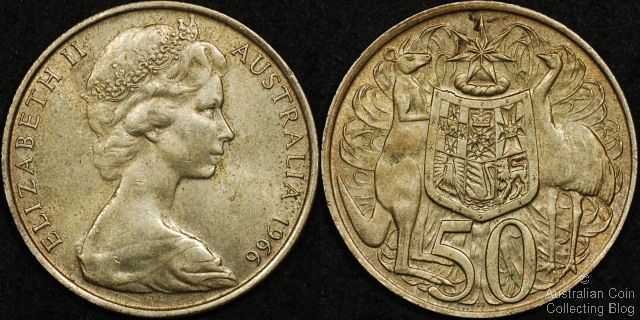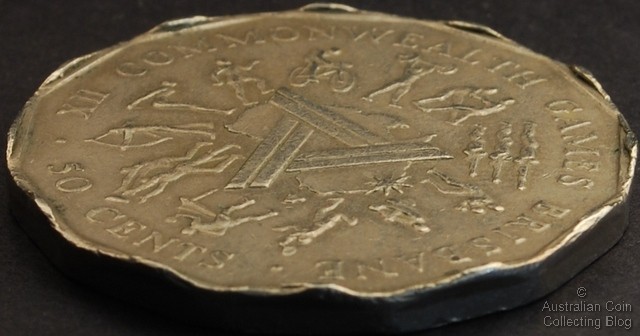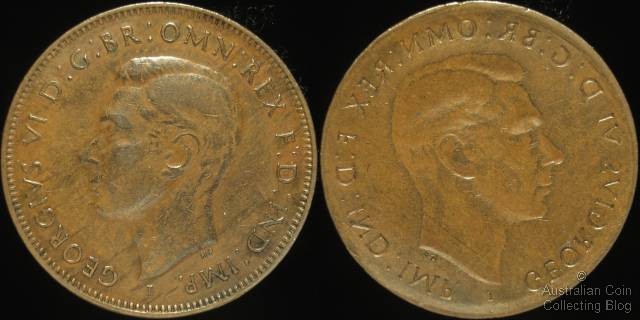February 2013 Archives

Australia 1966 50c
The legendary round 50 cent piece holds a special place in the hearts of many Australians. Those of us who are old enough to remember the decimal changeover remember the round 50 cent coin as an oddity that was hoarded by thousands of Australians. This was because in 1966 when the coin was issued the nearly 1/3 of an ounce of silver it contained was almost immediately worth more than the face value of the coin itself. Because of it's place in Australian folklore most people believe that the round 50c piece is a truly valuable coin. Sadly, because so many of these coins were minted (more than 36 million) they coin is neither scarce or particularly valuable In fact the 1966 50 cent coin value is generally only the value of the silver it contains.
Because of this, the round 50c bearing the Arnold Machin portrait of Queen Elizabeth II and the Stuart Devlin Coat of Arms reverse is only really traded as silver bullion. Some coins in exceptional grades may sell as numismatic coins but even these are only worth 2-3x the silver the coins contain. Bags of 100's of the coins regularly change hands purely for the intrinsic value of the silver they contain. Sometimes, no doubt, the coins reach the melting pot and are rendered down for the 80% silver each 13.28g coin contains.
With some internet trickery we can tell you that the silver value of a round 50 cent coin is currently AU$14.53 (US$9.62). This value is updated every hour or so using the current silver price and exchange rates from Kitco. If you want to know the value of a hoard of round 50c coins then please take a look at the Australian Silver Bullion Coin Calculator. This will tell you the bullion value of any number of 1966 50c coins plus the silver value of many other Australian Silver Coins.
If you want to buy a circulated round 50c piece for your collection then don't pay more than 10-20% above the bullion value of AU$14.53 (US$9.62) per coin. If you want a nice uncirculated coin or even a choice uncirculated coin then at time of writing (February 2013) we wouldn't recommend spending above $20 per coin.
NGC has brought to our attention what can only be labelled as the King of coin cuds. Their article
"Amazing Cud Error With Matching Die Steel Revealed" by Tom Delory
follows the surprising story of a US 1975-D cent with a massive cud where the die has broken away and the coin was struck with an incomplete obverse die. The most awesome part of the story is that in the bottom of the mint bag the coin was found in was the broken away piece of die! They now sit side by side in a multi coin NGC slab. Absolutely amazing.
If you're a collector of coins then chances are you know what to look out for in an error coin or know if a coin just doesn't look right or doesn't conform to the usual standard. Error coins are those that have had a mishap in the manufacturing process, either a deformation with the blank planchet or a mechanical error in the coin press.
Collecting these error coins can be very exciting and fulfilling to watch you achieve that rarer error type and add it to your collection. We've written a top ten list of the error types that are must have's in your error collection. It's fun to write a list when you first begin your collection and look back years later to see if you've fulfilled your desires. Some errors are easily found and some will take time and a lot of money to secure. Here's the list.
1. The Cud
Probably the easiest and cheapest coin error the coin cud is simply a chipped die which appears as a lump on the coin surface. Quite often they are found on the rim but can find their way onto a weak part of a coins design and can be quite small or very large. These can commonly be found in change or when searching bulk coin lots.
2. Coin Blank
Another reasonably cheap error coin is not really an error at all but an unstruck coin planchet is where every coin starts off. It's a fitting inclusion to an error collection. Make sure that your coin blank meets the exact specifications of the intended struck coin and ideally a coin blank planchet that has already been though the upsetting mill or rimming machine is more desirable as a collector piece.
3. Clipped Coin
The clipped error is a coin with a piece missing! The blanking press cutting out the planchets may have overlapped the edge of the metal coin strip, overlapped an already cut piece or an already cut coin, the resulting coin struck on an incomplete planchet can be a cool coin to have. Look out for key factors to help you determine a genuine ciip such as the Blakesley Effect and fishtailed lettering. It's very easy to be caught out buying worthless post mint damage thinking it's a genuine clip.

Cud (left) Clip (right)
4. The Partial Collar Strike
Occasionally a coin blank will fall into the coining chamber and won't be sitting in there straight. It will result in a coin struck with a partial straight or partial tilted collar, remembering the collar die is the third die that strikes the edge of the coin. If you're lucky you can find one of these in change, they are most commonly seen on dollars and the 5c. It's another must have in the ultimate error collectors collection.
5. A Ramstrike 50c
A ramstrike is a spectacular error that can take many forms but when it happens on an Australian 50c it's ultra cool and will take pride of place in your collection. The coin blank rotated slightly in the press and metal was forced upwards during the strike producing high metal lugs only seen because of the dodecagonal shape of the 50c. You'll aspire to own one of these interesting pieces.

Australian 50c Ramstrike
6. The Off-Centre Strike
Off-centre or broadstrike errors again can occur at a smaller or larger % of the coin. You may have an expensive error that is more blank than coin or a budget option of say just 5% off centre.
7. The Double Strike
This error can take on a couple of different forms, either a rotated double strike within the collar or a deformed planchet extra strike on the edge of the coin, the latter being the most spectacular type. It's interesting to examine these errors closely to see the design under the second strike and also how the design can be misshaped by the overlaying strike.
8. The Split Planchet
The ultimate split planchet is two coin halves that fit neatly together and display the planchet striations in the middle. You may only have half of the split coin and be searching for it's long lost mate or maybe your coin has only a split piece revealing those striations underneath.
9. The Wrong Planchet Coin
This is very much a right place wrong time planchet error. The wrong type or sized planchet has gotten mixed up in the barrel and been struck not as it was intended. An off-metal type or a planchet from another country or even a bi-metal planchet struck with the wrong design is a special addition and a worthy inclusion in this list. Be prepared to pay big bucks for one of these errors though.
10. The Brockage
Probably the ultimate coin error and the last on the list as it may take you some time to save up for this one. They are not too hard to find generally at least a couple available in every public coin auction but can be very pricey indeed. With either a double reverse (reverse brockage) or double obverse (obverse brockage) the second side is a mirror incused image of the other side of the coin.
Note: With long hard thinking we haven't included the double obverse or double reverse coin errors as their appearance can only be described as "mint sport". There's no possible way for a coin to be struck with two heads or two tails unless the completely wrong die was put in the press and a couple of coins struck for the amusement of mint staff. Their scarcity implies that no more than just a few dozen of these coins exist in all denominations, again indicating they were struck on purpose and with intent, not the lotto winning luck of the other top ten coin errors listed.

Australian Half Penny Full Obverse Brockage


